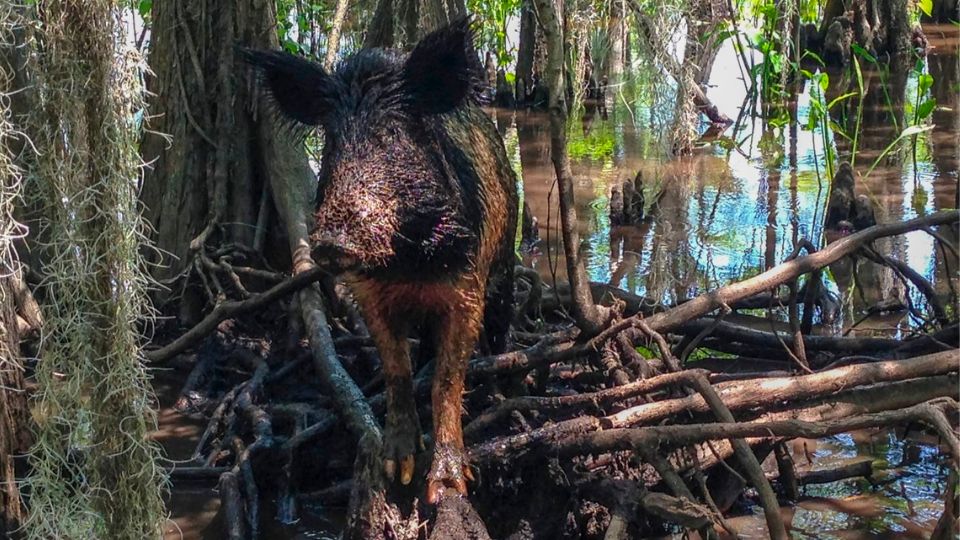Florida boasts a diverse array of wildlife, ranging from vibrant coral reefs to expansive wetlands. It’s worth mentioning that certain creatures in Florida can be dangerous to humans due to attacks, bites, stings, or disease transmission. Here are seven dangerous animals in the state to be cautious of and avoid.
American Alligator
The American alligator in Florida is considered one of the most impressive residents. These large reptiles can grow up to 15 feet long and weigh up to 1,000 pounds. With their strong jaws that can crush bones and shells, they are able to briefly run faster than humans on land.
Although they are usually not aggressive towards humans, they may become defensive if they feel threatened, hungry, or territorial, especially during mating season (April to June) and nesting season (June to September). Alligators can be found in a variety of freshwater environments such as lakes, rivers, swamps, marshes, ponds, and even certain saltwater regions.
Bull Shark
The bull shark is considered one of the most aggressive and unpredictable sharks in the world. It can survive in freshwater and is often found in Florida’s inland waterways like the St. Johns River, Lake Okeechobee, and the Everglades. Bull sharks have a reputation for attacking humans without being provoked and have been involved in more deadly shark incidents than any other species. Sharks can reach lengths of up to 11 feet, have blunt snouts, stocky bodies, and are gray with white bellies.
Eastern Diamondback Rattlesnake
Florida’s most dangerous serpent is the eastern diamondback rattlesnake, the largest venomous snake in North America. These snakes can grow up to 8 feet long and weigh up to 10 pounds. Recognizable by their dark brown or black diamond-shaped markings on a yellowish or grayish background, they also have rattles at the end of their tails.
Eastern diamondback rattlesnakes can be found in a variety of Florida habitats such as pine forests, sandhills, scrublands, and coastal areas. They are most active during spring and fall days and summer nights, primarily preying on rodents, rabbits, birds, and smaller animals. Their venom causes severe pain, swelling, bleeding, shock, and potential fatality if untreated.
Also Read: 7 Big Reasons Why People Don’t Like to Move in Arizona
Black Widow Spider
One of the most venomous spiders in Florida is the black widow, which has a shiny black body and a red hourglass-shaped mark on its abdomen, especially on females. Smaller males display lighter coloring with red or yellow spots on their backs. Black widows are commonly found in hidden, dim areas like under rocks, logs, debris piles, sheds, garages, basements, and attics.
Typically not aggressive, they only bite in response to being disturbed or feeling threatened. Their venom is harmful to the nervous system, causing symptoms such as muscle spasms, abdominal cramps, nausea, vomiting, headaches, dizziness, chest pain, and in rare instances, death.
Fire Ant
Fire ants from South America were unintentionally brought to Florida in the 1930s and have since become a significant problem for both agriculture and public health. These reddish-brown ants are about 1/8 inch long and live in large colonies with several queens. They build mounds that can grow up to 2 feet tall and several feet wide.
Fire ants are known for their aggressive nature and can sting multiple times with their venomous stingers found at the tips of their abdomens. When they sting you, it causes a burning feeling and can result in blisters, which might cause infections or scarring. Some people might have allergic reactions such as swelling, itching, hives, anaphylaxis (a serious condition that can lead to breathing difficulties), or even death.
Box Jellyfish
The box jellyfish, also known as the sea wasp or marine stinger, is considered one of the most venomous animals globally and poses a significant threat in Florida. Clear and shaped like a cube, they have four groups of tentacles, with each one capable of extending up to 10 feet. Every tentacle is filled with numerous tiny stinging cells that release powerful venom when touched.
Box jellyfish are found in warm tropical and subtropical waters, such as the Gulf of Mexico and the Atlantic Ocean. They are most commonly seen during the summer months, especially after storms or high tides. They do not attack, but will sting if they come into contact with swimmers or fish.
When stung by a box jellyfish, you may experience severe pain, redness, swelling, blisters, and tissue necrosis. The venom can impact the heart, nervous system, and respiratory system, possibly resulting in cardiac arrest, paralysis, coma, or death in a matter of minutes.
Florida Panther
The Florida panther, a subspecies of cougar found in Florida, is among the most endangered animals globally. There are only about 200 of these large cats left in the wild, mostly in the state’s southwest region. They can weigh up to 160 pounds and stretch up to 7 feet in length, nose to tail.
These animals are easily recognizable by their tawny coats, black facial markings, and unique tail kinks and cowlicks. They prefer to be active at night and usually live alone. They track down deer, hogs, raccoons, armadillos, and smaller animals in environments such as forests, swamps, prairies, and wetlands. Although they are not typically aggressive towards humans, they can become dangerous if provoked or trapped, potentially endangering livestock and pets.
In conclusion
To sum up, the wide variety of wildlife in Florida is a fascinating part of the state’s natural charm. Yet, recognizing and acknowledging the threats presented by these seven species can reduce the chances of harmful interactions. Following safety guidelines like avoiding provoking wildlife, maintaining a safe distance from potentially threatening animals, and seeking prompt medical attention if bitten or stung can help ensure a safer coexistence with Florida’s fascinating yet potentially dangerous creatures. Furthermore, informing authorities about sightings or incidents related to endangered or invasive species can help with conservation and public safety.



Leave a Reply